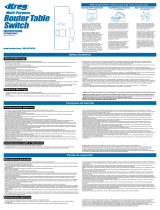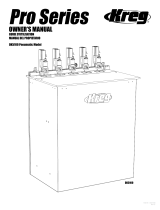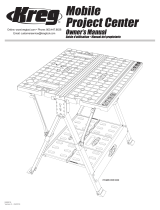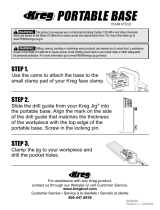Page is loading ...

NK8857
Version 3 - 4/2018
www.kregtool.com • 800.447.8638
Insert Plate
Precision Router-Table
INSTALLATION INSTRUCTIONS
Item # PRS4034
[Fits Triton TRA001 and MOF001]
Item # PRS4036
[Fits Bosch 1617, Porter-Cable 690 and 890 series]
Item # PRS4038
[Not drilled].
Parts:
• Insert Plate
• (3) Reducing Rings: 1", 1
3
16"
• Ring Wrench
machine screws (lock-down screws)
• ¼-20 x ¾" set screw
• Brass starting pin
• Router-base mounting screws
(pre-drilled insert plates only)
Tools Required:
• Phillips Screwdriver
• Masking Tape
• Double-faced Tape
• Drill press
• Drill Bits, Countersink Bit
• Router, top-bearing pattern bit
Pièces :
• Plaque d’insertion
• 3 anneaux de réduction : 1 po, 1 3/16 po
(douille de guidage), 2 5/8 po
• Clé pour anneau
• 4 vis à métaux à tête plate de 1/4-20 x 1 3/4 po
(vis de verrouillage)
• Vis de calage de 1/4-20 x 3/4 po
• Cheville de départ en laiton
• Clé hexagonale de 1/8 po
• Vis de montage pour la base de la toupie
(plaques d’insertion prépercées uniquement)
Outils nécessaires :
• Tournevis cruciforme
• Ruban-cache
• Ruban adhésif à double face
• Perceuse à colonne
• Forets, fraise
• Toupie, fraise à roulement à billes supérieur
Piezas:
• Placa de accesorio
• (3) anillos reductores: 1", 1
3
16"
• Llave de tuerca de anillo
• (4) tornillos de cabeza plana
• Llave de tuercas hexagonal de 1/8"
(solo placas de accesorio pretaladrados)
Herramientas necesarias:
• Destornillador Phillips
• Cinta adhesiva
• Cinta de doble faz
• Prensa de taladrar
• Brocas para taladro, broca para avellanar
rodamiento superior
INSTRUCTIONS POUR L’INSTALLATION
INSTRUCCIONES DE INSTALACIÓN
Article #PRS4034
(Convient aux modèles Triton TRA001 et MOF001)
Article #PRS4036
(Convient à la série 1617 de Bosch et aux séries 690 et
890 de Porter-Cable)
Article #PRS4038
(Non percé).
Artículo # PRS4034
[Se adapta a Triton TRA001 y MOF001]
Artículo # PRS4036
[Se adapta a Bosch 1617, series 690 y 890
de Porter-Cable]
Artículo # PRS4038
[Sin taladrado]
Logo on white, gray
or any lighter shade
when printing color
Logo on Pantone
2945 or any darker
shade when printing
color
Logo on white
or light shade when
printing grayscale
Logo on black or
dark shade when
printing grayscale

Safety Guidelines
1
1) Work area safety
a) Keep work area clean and well lit. Cluttered or dark areas invite accidents.
b) Don’t use power tools in a dangerous environment. Don’t use power tools
in damp or wet locations, or expose them to rain.
c) Do not operate power tools in explosive atmospheres, such as in the presence
ofammableliquids,gasesordust. Power tools create sparks that can ignite
the fumes or dust.
d) Keepchildrenandbystandersawaywhileoperatingapowertool.Distractions
can cause you to lose control.
e) Make your workshop child proof. Use padlocks, master switches,
or remove starter keys.
2) Electrical safety
a) Groundelectrictools.Ifthetoolisequippedwithathree-prongplug,itmust
bepluggedintoagroundedthree-holeelectricaloutlet. If the proper outlet is not
available,haveoneinstalledbyaqualiedelectrician.Neverremovethethirdprongor
modify the provided plug in any way.
b) Do not expose power tools to rain or wet conditions. Water entering a power tool
increases the risk of electric shock.
c) Donotabusethecord.Neverusethecordforcarrying,pullingorunpluggingthe
power tool. Keep cord away from heat, oil, sharp edges or moving parts. Damaged
or entangled cords increase the risk of electric shock.
d) Use a proper extension cord and make sure it is in good condition. When
using an extension cord, be sure to use one heavy enough to carry the current your
power tool draws. An undersized cord causes a drop in line voltage resulting in loss
of power and overheating. Table1 shows the correct cord gauge to use depending
on cord length and tool nameplate ampere rating. If in doubt, use the next heavier
gauge. The smaller the gauge number, the heavier the cord.
e) Whenoperatingelectrictools,avoidbodycontactwithgroundedorearthed
surfaces such as pipes, radiators, kitchen ranges, and refrigerators. Contact with a
grounded surface increases the risk of electric shock.
3) Personal safety
a) Stay alert, watch what you are doing and use common sense when operating
apowertool.Donotuseapowertoolwhileyouaretiredorundertheinuence
of drugs, alcohol or medication. A moment of inattention while operating power tools
can result in serious personal injury.
b) Always wear safety glasses. Everyday eyeglasses are not safety glasses. Safety
glasses have specially constructed lenses, frames, and side shields.
c) Usesafetyequipment. Use a face or dust mask when the cutting operation is
dusty. Safety equipment such as a dust mask, non-skid safety shoes, hard hat, or
hearing protection used for appropriate conditions reduces personal injuries.
d) Avoidaccidentalstarting.Makesuretheswitchisintheoff-positionbefore
plugging in.Carryingpowertoolswithyourngerontheswitchorplugginginpower
tools that have the switch on invites accidents.
e) Removeanyadjustingkeyorwrenchbeforeturningthepowertoolon.A wrench
or a key left attached to a rotating part of the power tool can result in personal injury.
f) Donotoverreach.Keepproperfootingandbalanceatalltimes. This enables
better control of the power tool in unexpected situations.
g) Secure workpieces. Use clamps or a vise to hold work when practical. This is safer
than using your hand and it frees both hands to operate the tool.
h) Neverstandonthemachine. Serious injury can occur if the tool tips or if the cutting
tool is unintentionally contacted.
i) Dress properly. Do not wear loose clothing or jewelry. Keep your hair, clothing
and gloves away from moving parts. Loose clothes, jewelry or long hair can be
caught in moving parts. Roll up long sleeves to the elbow. Wear protective hair covering
to contain long hair.
j) If devices are provided for the connection of dust extraction and collection
equipment,ensuretheseareconnectedandproperlyused.Use of these devices
reduces dust-related hazards.
4) Power tool use and care
a) Keep guards in place and in working order.
b) Do not force the power tool. Use the correct power tool for your application.
The correct power tool will do the job better and safer at the rate for which
it was designed.
c) Use the right tool. Don’t force a tool or attachment to do a job for which
it was not designed.
d) Do not use the power tool if the switch does not turn it on and off. Any power
tool that cannot be controlled with the switch is dangerous and must be repaired.
e) Disconnecttheplugfromthepowersourceand/orthebatterypackfromthe
powertoolbeforemakinganyadjustments,changingaccessories,orstoring
power tools. Such preventive safety measures reduce the risk of starting
the power tool accidentally.
f) Neverleaveatoolrunningunattended.Turnpoweroff. Don’t leave the tool
until it comes to a complete stop.
g) Store idle power tools out of the reach of children and do not allow persons
unfamiliar with the power tool and these instructions to operate the power tool.
Power tools are dangerous in the hands of untrained users.
h) Maintainpowertools.Checkformisalignmentorbindingofmovingparts,
brokenparts,andanyotherconditionthatcanaffectpowertooloperation.If
damaged,havethepowertoolrepairedbeforeuse. Many accidents are caused
by poorly maintained power tools.
i) Keep cutting tools sharp and clean. Properly maintained cutting tools with
sharp cutting edges are less likely to bind and are easier to control.
j) Use the recommended speed for the cutting tool or accessory
and workpiece material.
k) Onlyusepartsandaccessoriesrecommendedbythemanufacturer.
Consult the owner’s manual for recommended accessories.
Using improper accessories can cause personal injury.
l) Usethepowertool,accessories,andtoolbitsinaccordancewiththese
instructions and in the manner intended for the particular type of power tool,
takingintoaccounttheworkingconditionsandtheworktobeperformed.
Use of the power tool for operations different from those intended can result
in a hazardous situation.
5) Service
a) Haveyourpowertoolservicedbyaqualiedrepairpersonusingonlyidentical
replacement parts. This ensures that the safety of the power tool is maintained.
6) SAFETY INSTRUCTIONS SPECIFIC TO USING A ROUTER TABLE FITTED WITH A
PRECISION ROUTER TABLE-INSERT PLATE
a) Read, understand, and follow your router manufacturer’s safety warnings
and instructions.
b) Disconnecttherouterfrompowerbeforemakingadjustments.Neveradjust
the fence, plate, reducing rings, or any part of the router or router table while the
router is running.
c) Placetheroutertableonaatsurfacetopreventtippingorsliding.Never
stand on the router table.
d) Donotattempttoroutwarped,twisted,orbowedworkpieces.
Allworkpiecesmusthaveatfacesandsquareedges.
e) Donotattempttoroutverylargeworkpiecesonaroutertable. Very large
workpiecescanbedifculttocontrolandcancausetheroutertabletotipover.
f) Onlyuserouterbitsinyourrouter.Neverusetoolssuchascarvingburrs,
mounted abrasives, wire wheels, or drill pits, even if the shanks match the
diameter of the router collet.
g) Weargloveswhenhandlingrouterbits. Cutting edges are sharp.
h) Neverusedirty,dull,ordamagedrouterbits. Remove wood-resin build-up
withacleanerspecicallyformulatedforcuttingtools.Havedullbitssharpenedby
aqualiedperson.Discarddamagedbits.
i) Makesureatleast75%oftherouter-bitshanklengthissecurelyheldinthe
router collet. To ensure a secure hold, leave 1/16” to 1/8” (2mm-3mm) between
the end of the bit shanks and the bottom of the collet.
j) Usetheinsert-platereducingringwiththesmallestopeningthatallowsthe
bittopassthroughit. A large gap around the bit can allow the workpiece to tip
into the bit and kick back.
!
WARNING Read,understand,andfollowyourroutermanufacturer’sinstructionsinadditiontothesafetyprecautionsbelowtoreduceriskofre,
electric shock, and personal injury. Read all these instructions before attempting to operate this product. SAVETHESEINSTRUCTIONS.

Safety Guidelines
2
Nameplate
Amperes
@120 V
Extension Cord Length
25’ 50’ 75' 100' 150' 200'
Recommended Wire Gauge
0 -5 16 16 16 14 12 12
5.1 - 8 16 16 14 12 10 NR
8.1 -12 14 14 12 10 NR NR
12.1 - 16 12 12 NR NR NR NR
NR–NotRecommended
TABLE 1
k) Positionthefencefacesascloseaspossibletothebit.
Turn the bit by hand to check for interference. Firmly tighten the
fence-face T-knobs before routing.
l) Adjustrouterspeedtomatchthediameterofthebit. Reduce router speed
when using large-diameter bits. See Table2 for recommended router speeds.
m) Makesuretheroutermotorissecurelyclampedinthebasebefore
starting the router.
n) Always support the workpiece with the fence or start pin.
Only use the starter in with router bits that have a guide bearing.
o) Whenusingthefence,alwayspositionthebitguardovertherouterbit
andasclosetotheworkpiecesurfaceaspossible.
p) Neverremovealargequantityofstockinonecut.Make several
progressively deeper cuts, adjusting the router bit or fence position between cuts.
q)Keephandsawayfromtherotatingbitandyourbodyoutofthepathof
the cut. Always use the bit guard, use push sticks, push blocks, and feather
boards whenever possible, especially when routing narrow workpieces.
Turn off the router before clearing parts of scrap.
r) Avoid awkward hand positions, where a sudden slip could cause contact
withtherotatingbit.Neveroverreach.
s) Avoid routing small parts.Routtheproleonalargeworkpieceandthencut
theparttonalsizefromthelargeworkpiece.Ifyoumustroutasmallpart,build
an appropriate jig or hold the part with a wood handscrew clamp.
t) Makesuretheworkpieceisclearofthebitandthebitcomestoa
completestopbeforeadjustingtheworkpieceposition.Neverstarttherouter
with the workpiece in contact with the bit.
u) Avoidkickbacks.Kickbacksoccurwhentheworkpiecebindsorliftsoff
thetablewhilebeingrouted,causingittobethrownbacktowardthe
operator. To avoid kickbacks and potential injury, use sharp bits, keep the
machine aligned and maintained properly, and adequately support the workpiece.
Do not attempt to rout workpieces that are twisted, warped, or bowed,
or that have loose knots.
v) Feedtheworkpieceagainst(notwith)thebitrotation. The bit can grab a
workpiece fed with the rotation of the bit, violently eject it from the router table,
and can cause your hand to contact the bit.
w) Nevertrapaworkpiecebetweenthebitandthefence. When forming a
proleonthestraightedgeofaworkpiece,alwaysroutwiththebithousedinthe
fence and the edge of the workpiece against the fence.
x) Wheneverroutingaproleinwhichmaterialisnotbeingremovedbelow
aprotrudingportionofthebit,orapartoftheproleistrappedbetween
cuttersaboveandbelow,takeextraprecautionstopreventtheworkpiece
fromliftingoffthetablesurfaceduringrouting.A workpiece lifting off the table
cankickbackandcauseseriouspersonalinjury.Whenroutingtheseproles,itis
especiallyimportanttousestraight,atstockandavoidwarped,bowed,ortwistedstock.
y) Periodically check the tightness of fasteners and adjustment and locking
knobsandthealignmentofthefence.Loose fasteners and knobs and a
misaligned fence can cause personal injury.
z) Thisroutertableinsertisdesignedforaspecicapplication.
Do not modify and or use it for any other application. If you have questions
relativetotheapplicationoftheinsert,DONOTuseituntilyouhavecontacted
Kreg Tool Company and have been advised accordingly.
Guidelines for extension cord use
Extension cords are only to be used for temporary purposes. They do not replace the
need for installation of outlets and proper wiring where necessary.
In the shop and on construction sites:
1. Extension cords with an equipment grounding conductor must be used at all times.
2. Extension cords must be protected from damage, and not run through doorways
or windows where the doors or windows can close, causing damage to the cord.
3. Extension cords must be a minimum of 16 AWG and be rated for
the equipment in use.
4. Extension cords must be periodically inspected to ensure that the insulation and
conductivity of the wires are not compromised.
5. Extension cords should not be run through water or allowed to have connections
that may be exposed to accumulated water.
Always follow bit manufacturer’s speed recommendations. Some bit designs require
specicspeedsforsafetyorperformance.
TABLE 2
Recommended Router Bit Speeds
Bit Diameter Maximum Speed (RPM)
24,000
(32mm-51mm)
18,000
(57mm-64mm)
16,000
(76mm-89mm)
12,000
WARNING:
!
This product can expose you to chemicals including Acrylonitrile
and other chemicals, which are known to the State of California to cause cancer and
reproductive harm. For more information go to www.P65Warnings.ca.gov.
WARNING:
!
Drilling, sawing, sanding or machining wood products can expose
you to wood dust, a substance known to the State of California to cause cancer. Avoid
inhaling wood dust or use a dust mask or other safeguards for personal protection.
For more information go to www.P65Warnings.ca.gov/wood.

These instructions show you how to mount your router on the Kreg Precision Router-Table Insert Plate and install the insert plate in
a shop-built router table. There are two installation methods:
• Create an opening with a rabbeted edge that accepts the insert plate.
• Create a straight-sided opening and install Kreg Precision Router Table Insert Plate Levelers (sold separately).
PRS4034 and PRS4036 insert plates are pre-drilled to accept most Triton, Bosch, and Porter-Cable routers. For these plates,
simply fasten your router base to the insert plate using the screws provided with the plate.
Drill the Insert Plate.
Before you start...
Precision Insert Plate Installation
3
Router sub-base
B
C
A
1. PRS4038 has center points molded into the bottom face for drilling mounting
holes for the following routers [Drawing A]:
Pattern 1 (three holes): Bosch 1617 and 1618; DeWalt 616 and 618; Hitachi
M12VC; Makita 1100; Milwaukee 5616 and 5624; Porter-Cable 690, 890, 7529,
97529, and 8529; and Ridgid 2930 Combo Kit.
Pattern 2 (four holes): Milwaukee 5625-20; Porter-Cable 7518, 7519, 7538, and
7539; and Triton TRA001 and MOF001.
Drill holes and counterbores or countersinks to accommodate the mounting
screws supplied with the router. For routers equipped with a built-in lift system,
use the router sub-base as a guide for the location and size of the access hole
and as a drilling guide.
For routers not covered by Pattern 1 or Pattern 2, follow Steps 2 and 3
below.
2. Place the insert plate on your workbench with the target pattern facing
mounting holes. If your router is equipped with a built-in lift system, also select
tape to the sub-base. Center the sub-base on the insert plate, using the target
pattern as a guide [Drawing B]. Keep in mind where you want the router
controls positioned. Make sure that none of the holes you are about to drill
the insert plate.
3. Place a scrapwood backer board under the insert plate and securely
clamp the insert plate and backer to your drill-press table. Using the holes in
the sub-base as guides, drill holes in the insert plate [Drawing C]. With the
holes drilled, remove the sub-base from the insert plate. Flip the insert plate
over and countersink the mounting holes so the mounting-screw heads sit
slightly below the plate surface when tightened. Store the router sub-base in
a convenient place. You will need it when you remove your router from the
router table for hand-held routing.
P1
P2
P1
P1
P2
P2
P2

Precision Insert Plate Installation
4
Form the insert-plate opening in your router table top
3
⁄8"
1
3
⁄
4
"
1
3
⁄
4
"
Routing guide
Masking
tape shim
Double-faced tape
Drill bit
touches guides
Drill 1½" hole
Router
table top
D
E
F
Rabbeted opening method
1. Position the insert plate on your router table top, squaring the plate with the
table. Trace around the plate with a pencil. Remove the plate. To form areas to
secure the insert plate to the router table top, draw 45° lines across each corner
of the outline to form triangles with 1 ¾"-long legs [Drawing D]
inside and parallel to the traced insert-plate outline.
2. To provide clearance for installing and removing the insert plate, adhere
strips of masking tape to all four edges of the plate. Then apply small pieces of
Too much tape will make the plate hard to remove later.) Reposition the insert
3. Cut four ¾ x 3½ x 15½" scrapwood routing guides. Apply double-faced tape
and adhere the routing guides to the router table top with the edges against the
masking tape strips on the insert plate edges [Drawing E]. Remove the plate.
Chuck a 1½" Forstner bit into your drill press. Drilling test holes in the area of
[Drawing F].
4. Drill a blade-start hole inside the pencil lines. With the outside edge of your
inside the insert-plate outline as well as the triangular areas at each corner.
5. Chuck a top-bearing pattern bit with a ¾" cutting length into your router.
guide. Make test cuts in scrap stock to ensure that the cut depth exactly
matches the thickness of the insert plate. Rout the perimeter rabbet and the
corner triangles in several passes until the pattern-bit guide bearing runs
smoothly against the edges of the routing guides [Drawing G]. Be sure to stop
routing along each side where the ¾"-radius corners formed by the drilled holes
meet the routing guides.
the routing depth, and re-rout the rabbet. A too-deep rabbet can be shimmed
Routing Guides
Radius corner formed by
Forstner bit
G
6. With the insert plate in place, use the countersunk corner holes as guides
to drill ¼" holes through the triangular corner areas in the table top. Secure the
plate with the lock-down screws and your own washers and hex nuts or wing
nuts. For greater convenience, remove the insert plate, enlarge the holes in the
table top, and install T-nuts.

Precision Insert Plate Installation
5
Routing guide
Masking
tape shim
Double-faced tape
Router table top
Routing guides
Radius corner formed
by Forstner bit
Pattern bit
H
Drill bit
touches guides
Drill 1½" hole all
the way through
I
J
!
Kreg Precision Router Table Insert Plate Levelers method
ATTENTION! This method requires the purchase of Kreg Precision Router Table Plate Levelers from your Kreg dealer. These
1. To provide clearance for installing and removing the insert plate, adhere strips
of masking tape to all four edges of the plate. Then apply small pieces of double-
much tape will make the plate hard to remove later.) Position the insert plate on
place.
3.
cutting from corner hole to corner hole. For best results, support the inside edge
4. Chuck a top-bearing pattern bit into your router. With the guide bearing
running against the routing guides, rout the edges of the opening
[
Drawing J
]
.
Stop routing where the ¾"-radius corners formed by the drilled holes meet the
routing guides. If the thickness of your router-table top is greater than the reach
the surface routed with the pattern bit. Remove the routing guides.
2. Cut four ¾ x 3½ x 15½" scrapwood routing guides. Apply double-faced tape
and adhere the routing guides to the router table top with the edges against
the masking tape strips on the insert plate edges
[
Drawing H
]
. Remove the
touching the inside faces of the routing guides, drill a hole all the way through the
router-table top at each corner
[
Drawing I
]
.
Install the Insert Plate
Rabbeted opening method
1. Attach the router base to the insert plate, using the screws that were used to
attach the sub-base to the router base. Depending on the thickness of your router
sub-base, it may be necessary to purchase longer screws. Make certain that
routers, install the motor unit in the router base and install the insert plate, with
router attached, in the table.
2. Drop the four lock-down screws through the countersunk holes in the insert
plate and thread them into the hex nut, wing nut or T-nut. Tighten the screws.

Precision Insert Plate Installation
6
Router table top
Mating Curves
K
!
Kreg Precision Router Table Insert Plate Levelers method
1.
With the table top upside down, position an insert-plate leveler in one corner
of the table-top opening, mating the curve on the raised portion of the leveler
with the radius corner of the opening. Firmly holding the leveler in place and
into the table top. Fasten the leveler to the tabletop with three 1¼" coarse-thread
screws provided
[
Drawing K
]
. Repeat with the remaining levelers.
ATTENTION! The 1¼" coarse-thread screws provided with the levelers are
for use on router table tops with a minimum thickness of 1". For thinner tops, use
your own shorter screws.
2.
each outside hole in each leveler, threading them in from the bottom until the tips
3. For Kreg PRS4034 and PRS4036 Precision Insert Plates, fasten the router
base to the insert plate using the screws supplied with the plate. For the Kreg
PRS4038 Precision Insert Plate, use the screws that were used to attach the
sub-base to the router base to attach the router base to the insert plate. Make
certain that the screws are long enough to fully thread into the router base. It
motor unit in the router base.
Lock-down screw
Set screw
Hex wrench
Insert plate
L
4. Place the insert plate with the router attached in the table-top opening,
from under the table to align the surfaces of the plate and the table. Check
the alignment with a straight edge. Make sure all eight set screws are in equal
contact with the insert plate
5. Thread the four ¼-20 x 1¾" machine screws (lock-down screws) through the
countersunk holes in the insert plate and into the center hole on each leveler and
snug them down
[
Drawing L
]
Finishing Up
Starting pin
Set screw
M
1. Thread the ¼-20 x ¾" set screw into the bottom of the brass starting pin using
together
[
Drawing M
]
. When ready for use, thread the starting pin assembly into
the threaded hole in the insert-plate and tighten it.

Precision Insert Plate Installation
7
Unlock
Lock
Wrench
Reducing ring
N
!
ATTENTION! The Kreg Precision Insert Plate includes three Level-Lock
the diameter of the router bit in use. The ring with the rabbeted opening accepts
standard universal-style guide bushings, allowing you to use your router table
for pattern routing. A set of four additional reducing rings plus a blank disk for
making a zero-clearance ring is available from your Kreg dealer.
General Routing
Starting Pin
(A) Use the insert-plate reducing ring with the smallest opening that allows the
bit to pass through it. (B) Position the fence faces as close as possible to the
bit. Turn the bit by hand to check for interference. Firmly tighten the fence-face
T-knobs before routing. (C) Position the bit guard over the router bit and as close
to the workpiece surface as possible. (D) Feed the workpiece against (not with)
the (E) bit rotation.
!
To use the starting pin, begin with your workpiece touching the pin, but not
in contact with the router bit. Slowly pivot the workpiece into the bit until the
workpiece makes contact with the bit guide bearing. Always feed the workpiece
so the router bit rotates against (not with) the feed direction. With the workpiece in
solid contact with the guide bearing, ease the workpiece off of the starting pin and
feed the workpiece along the guide bearing.
WARNING! Use the starting pin when routing along curved edges and only
with router bits that have a guide bearing. When routing against straight edges,
always use the fence.
A
E
B
C
D
2. To install a reducing ring, simply drop it into the insert-plate opening and turn
the arms of the ring wrench into the mating holes in the reducing ring and rotate
the ring counterclockwise
[
Drawing N
]
the ring in place. To remove the ring, turn the wrench clockwise and lift the ring
out of the opening.

For assistance with any Kreg product, contact us through our Web site or call Customer Service.
Si vous avez besoin d’aide concernant les articles Kreg, communiquez avec nous
surnotresiteWebouappeleznotreserviceàlaclientèle.
Si requiere asistencia con cualquier producto Kreg, póngase en contacto con nosotros
a través del sitio web o llame al Servicio al Cliente.
www.kregtool.com • 800.447.8638
Logo on white, gray
or any lighter shade
when printing color
Logo on Pantone
2945 or any darker
shade when printing
color
Logo on white
or light shade when
printing grayscale
Logo on black or
dark shade when
printing grayscale
/










